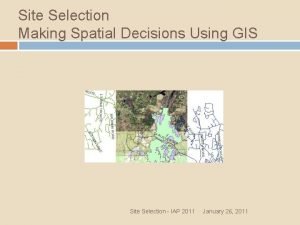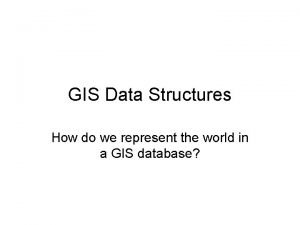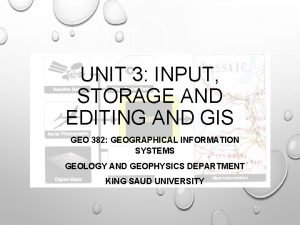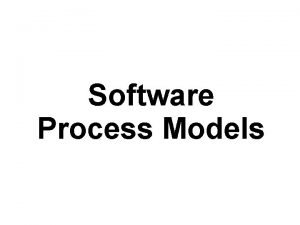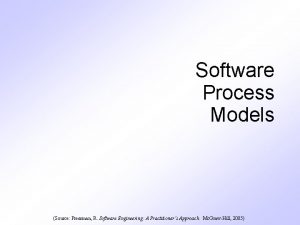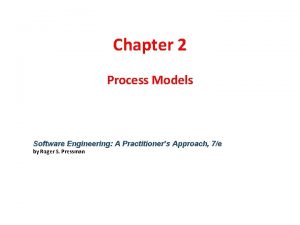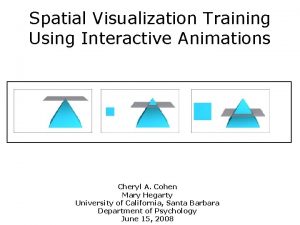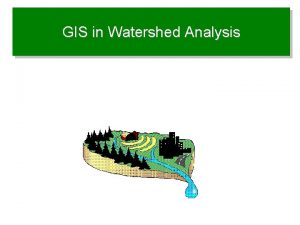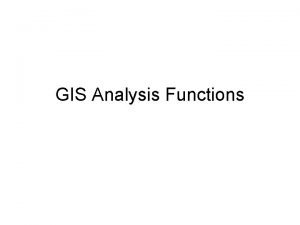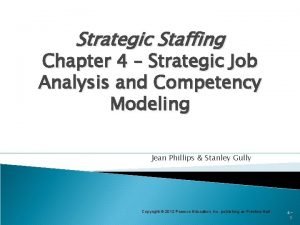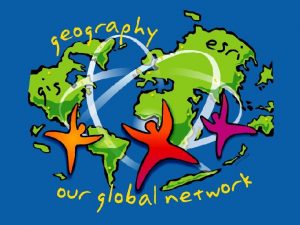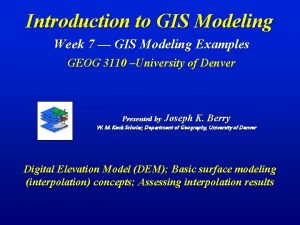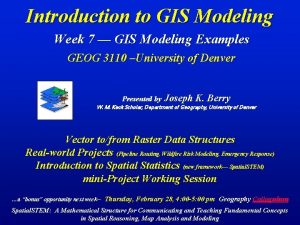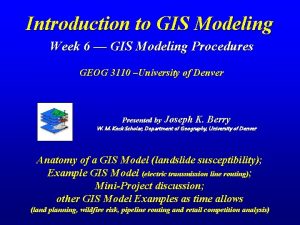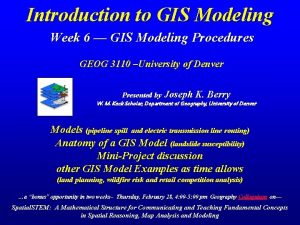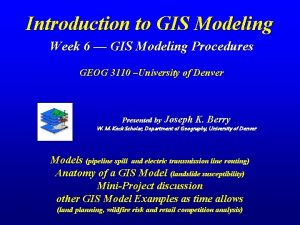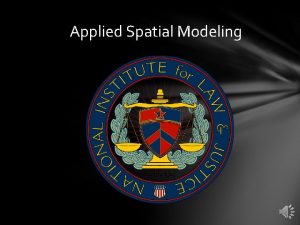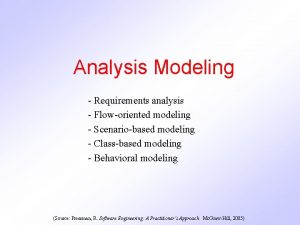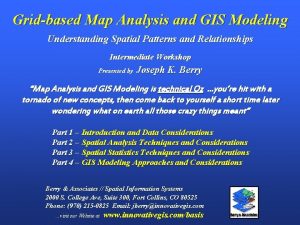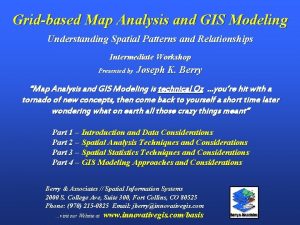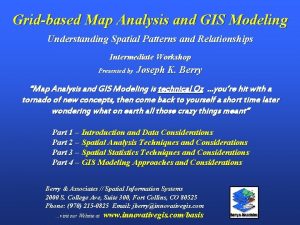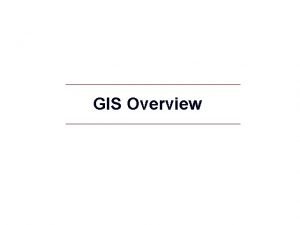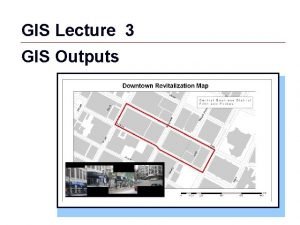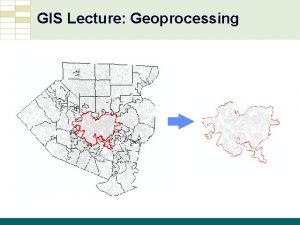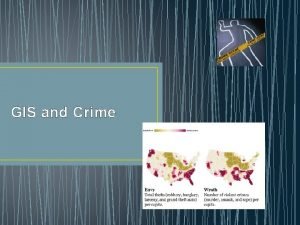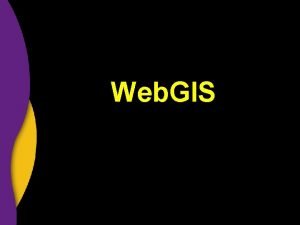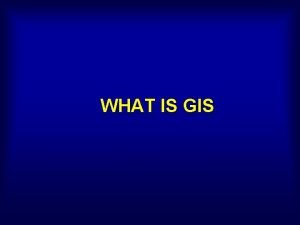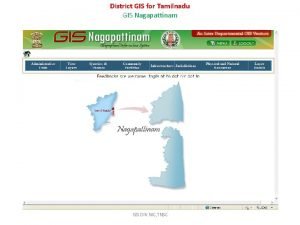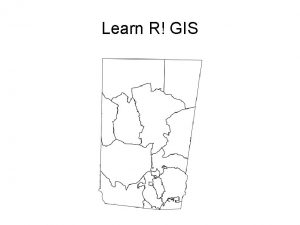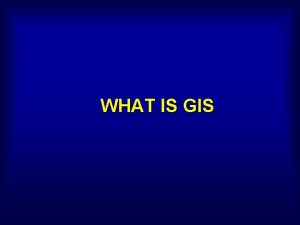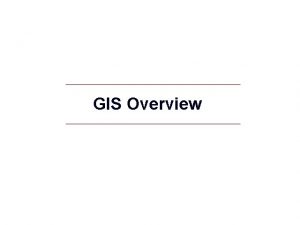Spatial Analysis Modeling GIS for Spatial Planning Training



























- Slides: 27

Spatial Analysis & Modeling GIS for Spatial Planning Training for Ministry of Transport Mozambique Maputo, Mozambique 2 -13 July 2018 Geoinformation and Sectoral Statistics Section

Content Spatial Analysis and Modeling Concepts Surface Modeling Operations 2

Spatial Analysis & Modeling Concepts Spatial analysis is the technique to analyze data in terms of location Find out patterns, identify relationships among features, plan efficient routes, perform site selection, model or predict values based on discrete sample observations, etc. Relationships: proximity, overlap, intersection, visibility, accessibility, etc. Detect patterns: hotspots, outliers, clusters, change over time

Spatial Analysis & Modeling Concepts Predict values: given a set of measured points across an area you can determine the estimated values in unmeasured locations Using spatial analysis, you can combine information from many independent sources and derive a new set of information by applying a large, rich, and sophisticated set of spatial operators or geoprocessing tools 4

Spatial Analysis & Modeling Concepts Why Spatial modeling: finding relationships among geographic features to understand address any particular problem Spatial modeling allows you to derive new data from values of existing data layers and to predict what might happen and where Modeling often involve developing specialized workflows through programming, creating scripts and automated workflows, lets you efficiently query and process large amounts of data and implement more complex algorithms.

Spatial Analysis & Modeling Concepts Models help you understand, describe, and predict how things work in the real world Spatial modeling, modeling spatial problems, involve two types of models: Representation models – represent the objects in the landscape Process models – simulate the processes in the landscape 6

Spatial Analysis & Modeling Concepts Spatial Analysis Raster model Vector model 7

Spatial Analysis & Modeling Concepts Using an elevation surface, for example, you can derive information and identify features that were not readily apparent in the original surface, contours, angle of slope, steepest downslope direction (aspect), shaded relief (hillshade), and visible areas (viewsheds) model the flow of water across Earth’s surface, deriving runoff characteristics, understanding drainage systems, and creating watersheds

Surface Models Surface Models: DSM, DEM, DTM Digital Surface Model (DSM) surface model which captures the natural and built features on the Earth’s surface DSM is generated using Li. DAR system, which sends pulses of light to the ground and when the pulse of light bounces off/back its target and returns to the sensor, it gives the range (a variable distance) to the Earth Li. DAR delivers a massive point cloud filled of varying elevation values (Height can come from the top of buildings, tree canopy, power lines, other built and natural features) DSM is useful in 3 D modeling for telecommunications, urban planning and aviation (objects extrude from the earth, particularly useful in these application to identify obstructions)

Surface Models DSM 10

Surface Models Digital Elevation Model (DEM) is a digital model or 3 D representation of a terrain’s surface, created from DEM is bare-earth raster grid, which filters out vegetation and man made features terrain elevation data DEM is bare-earth raster grid, which filters out vegetation and man made features non-ground points such as bridges and roads, built (power lines, buildings and towers), and natural (trees and other vegetation types) are not included in DEM Digital Elevation Model (DEM) is frequently used and simplest form of digital representation of topography

Surface Models Ø DEM is used to determine terrain attributes such as elevation, slope and aspect Ø Terrain features such as drainage basins and watersheds, drainage networks and channel can be identified from DEMs. Ø Widely used in hydrologic modeling, and geologic analysis, soil mapping 12

Surface Models A Digital Terrain Model (DTM) is a vector data set composed of regularly spaced points and natural features such as ridges and breaklines. DTMs are typically created through stereo photogrammetry From these regularlyspace and contour lines, you can interpolate a DTM into a DEM 13

Surface Modeling Operations Surface modeling operations include: Contour Slope Aspect Hillshade Viewshed Visibility Cut Fill Interpolation

Surface Modeling Operations Aspect (Spatial Analyst) Derives aspect from a raster surface. The aspect identifies the downslope direction of the maximum rate of change in value from each cell to its neighbors. Aspect can be thought of as the slope direction. The values of the output raster will be the compass direction of the aspect. Aspect is expressed in positive degrees from 0 to 359. 9, measured clockwise from north. 15

Surface Modeling Operations Slope (Spatial Analyst) Identifies the slope (gradient, or rate of maximum change in z-value) from each cell of a raster surface. 16

Surface Modeling Operations Contour (Spatial Analyst) Contours represent points having equal heights/ elevations with respect to a particular datum such as Mean Sea Level (MSL) Topographic maps, shape of a landscape represented with contour lines A way to describe threedimensional landscapes in two dimensions 17

Surface Modeling Operations Contour (Spatial Analyst) Contour tool: Creates a line feature class of contours (isolines) from a raster surface. A base contour is used; e. g. to create contours every 10 meters, starting at 5 meters 5 is the base contour, and 10 is the contour interval. values to be contoured 5, 15, 25, 35, 45, … 18

Surface Modeling Operations Hillshade (Spatial Analyst) Hillshade tool: Creates a shaded relief from a surface raster by considering the illumination source angle and shadows. The hillshade raster has an integer value of 0 to 255, o representing 19

Surface Modeling Operations Viewshed (Spatial Analyst) Determines the raster surface locations visible to a set of observer features Useful in application like telecommunication 20

Surface Modeling Operations Spatial interpolation is used to take known values and interpolate them into a surface, deriving new estimated surface values Elevation points interpolated to generate DEM Contour lines interpolated to generate DEM Using interpolation methods, users can create surfaces from sampled locations without having to visit every location of a study area, saving time and effort.

Surface Modeling Operations Interpolation(Spatial Analyst) Interpolation is creating a surface based on a sample of values with the domain Different techniques for interpolation: IDW (Inverse Distance Weighting) Kriging Natural Neighbor Spline 22

Surface Modeling Operations IDW: Interpolates a raster surface from points using an inverse distance weighted (IDW) technique Values for nearby points tend to be more similar IDW weights the value of each point by its distance to the cell being analyzed and averages the values It assumes that unknown value is influenced more by nearby points than far away points 23

Surface Modeling Operations Spline: Interpolates a raster surface from points using a twodimensional minimum curvature spline technique. It fits a curve through the sample data and assigns values to other locations based on their location on the curve Regularized Method: results in a smoother surface that smoother areas of abruptly changing values Tension Method: results in a rougher surface that more closely adheres to abrupt changes in sample points 24

Surface Modeling Operations Kriging Method: Interpolates a raster surface from points using kriging. Like IDW interpolation, Kriging forms weights from surrounding measured values to predict values at unmeasured locations. IDW uses a simple algorithm based on distance Kriging weights come from a semi-variogram that is developed by looking at the spatial structure of the data Predictions are made for locations in the study area based on the semivariogram and the spatial arrangement of measured values that are nearby Semi-variograms measure the strength of statistical correlation as a function of distance; they quantify spatial autocorrelation Kriging associates probability with each prediction 25

Surface Modeling Operations Raster Calculator (Spatial Analyst) Builds and executes a single Map Algebra expression using Python syntax in a calculator-like interface. 26

THANK YOU! denekewa@Un. org
 Helen c. erickson nursing theory
Helen c. erickson nursing theory Dimensional modeling vs relational modeling
Dimensional modeling vs relational modeling Making spatial decisions using gis
Making spatial decisions using gis Spatial data structures in gis
Spatial data structures in gis Spatial data editing in gis
Spatial data editing in gis Spatial data vs non spatial data
Spatial data vs non spatial data Generic process model diagram
Generic process model diagram Waterfall model pressman
Waterfall model pressman Communication planning modeling construction deployment
Communication planning modeling construction deployment Evolutionary software process models
Evolutionary software process models Modeling and imitation training aba
Modeling and imitation training aba Physical spatial approach in tourism planning
Physical spatial approach in tourism planning Spatial visualization training
Spatial visualization training Gis watershed analysis
Gis watershed analysis Gis analysis functions
Gis analysis functions Gis analysis functions
Gis analysis functions Simulation modeling and analysis law kelton
Simulation modeling and analysis law kelton Dfd chapter 5
Dfd chapter 5 System requirements checklist output example
System requirements checklist output example Competency modeling vs job analysis
Competency modeling vs job analysis Manufacturing systems modeling and analysis
Manufacturing systems modeling and analysis Ksao job analysis example
Ksao job analysis example Fspos vägledning för kontinuitetshantering
Fspos vägledning för kontinuitetshantering Typiska novell drag
Typiska novell drag Nationell inriktning för artificiell intelligens
Nationell inriktning för artificiell intelligens Vad står k.r.å.k.a.n för
Vad står k.r.å.k.a.n för Varför kallas perioden 1918-1939 för mellankrigstiden?
Varför kallas perioden 1918-1939 för mellankrigstiden? En lathund för arbete med kontinuitetshantering
En lathund för arbete med kontinuitetshantering


